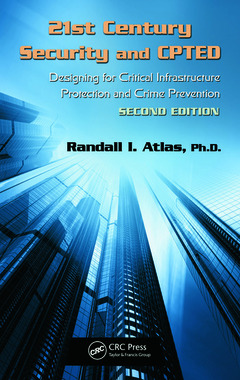Description
21st Century Security and CPTED (2nd Ed.)
Designing for Critical Infrastructure Protection and Crime Prevention, Second Edition
Author: Atlas Randall I.
Language: English
Subjects for 21st Century Security and CPTED:
Keywords
FEMA; CPTED Practitioner; Randall I; Atlas; Natural Surveillance; CPTED; Parking; security; Parking Area; assessing threats; ISC; infrastructure protection; CPTED Strategy; terrorism; site design; ASIS International; ASIS; CBR; Critical Infrastructure Protection; Defensible Space; South Florida Sun Sentinel; Security Design; GSA Security Standard; Exterior Lighting; Workplace Violence; Access Control; Swat; Smart Growth; Natural Access Control; Vulnerability Rating; Standoff Distance; Crime Prevention
640 p. · 17.8x25.4 cm · Paperback
Description
/li>Contents
/li>Readership
/li>Biography
/li>
The concept of Crime Prevention Through Environmental Design (CPTED) has undergone dramatic changes over the last several decades since C. Ray Jeffery coined the term in the early 1970s, and Tim Crowe wrote the first CPTED applications book. The second edition of 21st Century Security and CPTED includes the latest theory, knowledge, and practice of CPTED as it relates to the current security threats facing the modern world: theft, violent crime, terrorism, gang activity, and school and workplace violence.
This significantly expanded edition includes the latest coverage of proper lighting, building design?both the interior and exterior?physical security barriers, the usage of fencing, bollards, natural surveillance, landscaping, and landscape design. Such design concepts and security elements can be applied to address a wide variety of threats including crime prevention, blast mitigation, and CBRNE threat protection.
Authored by one of the U.S.?s renowned security experts?and a premiere architect and criminologist?the book is the most comprehensive examination of CPTED and CPTED principles available. This edition includes a complete update of all chapters in addition to five new chapters, over 700 figure illustrations and photos, numerous tables and checklists, and a 20-page color plate section. This latest edition:
- Features five new chapters including green and sustainable buildings, infrastructure protection, and premises liability
- Presents step-by-step guidelines and real-world applications of CPTED concepts, principles and processes?from risk assessment to construction and post-occupancy evaluation
- Outlines national building security codes and standards
- Examines architectural surety from the perspective of risk analysis and premises liability
- Demonstrates CPTED implementation in high-security environments, such as hospitals, parks, ATMs, schools, and public and private sector buildings
A practical resource for architects, urban planners and designers, security managers, law enforcement, CPTED practitioners, building and property managers, homeland security professionals, and students, 21st Century Security and CPTED, Second Editioncontinues to serve as the most complete and up-to-date reference available on next-generation CPTED practices today.
Background and Theory. Protecting the Built Environment. Applications of CPTED in the Built Environment.
Randall I. Atlas, PhD, AIA, CPP, is president of Atlas Safety & Security Design, Inc., in Fort Lauderdale, Florida. Dr. Atlas is a nationally recognized speaker, trainer, and writer on crime prevention through environmental design (CPTED) and has worked in these capacities for the National Crime Prevention Institute (NCPI), the American Institute of Architects (AIA), and the American Society of Industrial Security (ASIS). Dr. Atlas is a certified protection professional (CPP) with ASIS and is a member and past chairman of the Security Architecture and Engineering Council (SAEC). He is a human factors and ergonomics expert and is a member of the Human Factors and Ergonomics Society and the Environmental Design Research Association (EDRA). He was a technical assistance consultant to the U.S. Department of Housing and Urban Development (HUD) Drug Elimination Grant Program and has conducted numerous CPTED and infrastructure security audits throughout the United States. Dr. Atlas has contributed numerous articles to the Protection of Assets manual and Access Control & Security Systems, Security Technology & Design, Security Management, Door Hardware Institute, and Parking Today magazines.
Dr. Atlas serves on the National Fire Protection Association 730 Committee on Premises Security, has contributed to NFPA 730: Guide for Premises Security (NFPA, 2006–2012, Quincy, MA), and has served on the ASIS Physical Security Guidelines Committee, developing the Facility Physical Security Measures (2009) publication. Dr. Atlas serves on the American Society of Testing Materials (ASTM) technical committees F33 on Corrections and Detention Facilities, ASTM E54 Homeland Security Committee, F13 Pedestrian/Walkway Safety and Footwear, and F12 Committee on Security Systems and Equipment. He is a member of the International Society of Crime Prevention Practitioners; the International Association of Counterte




